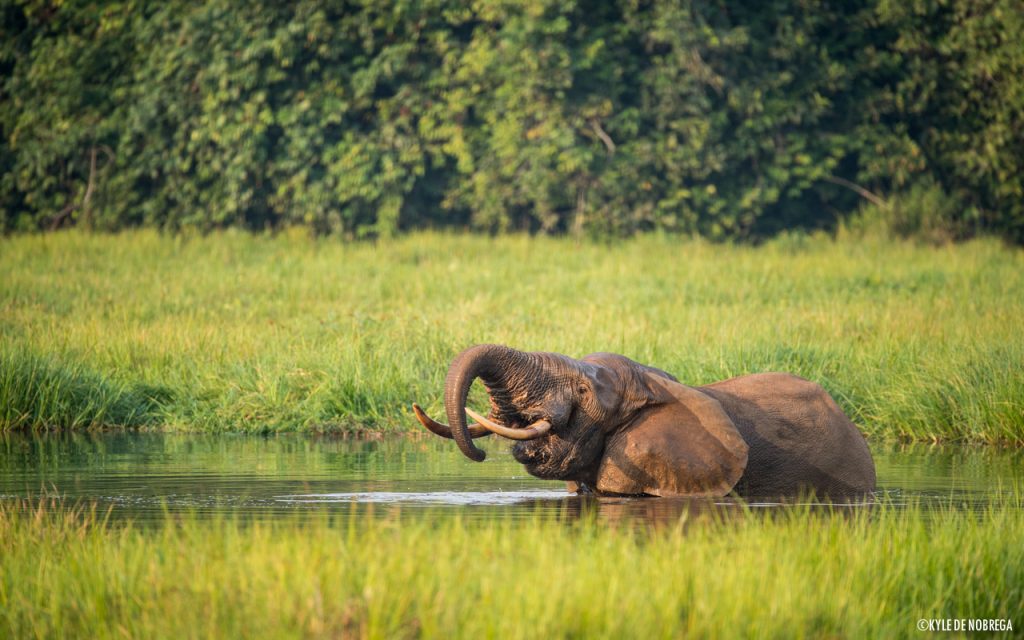Scientific research, an essential tool for the conservation of forest elephants
For more than 25 years, scientists have been monitoring, studying and observing Mbeli bai’s wildlife in the Nouabalé-Ndoki national park. The Mbeli study is named after the bai , or clearing, where the research is conducted. Forest elephants, a still little known and often overlooked sub-species, are frequently observed in this unique landscape. The Mbeli study has contributed essential knowledge to the development of improved elephant conservation strategies that better address the threats posed by ivory trafficking, poaching and habitat fragmentation.

The Mbeli bai study site is a natural swampy clearing of about 15 hectares that offers a unique opportunity to observe species such as West African lowland gorillas and forest elephants in their natural habitat. WCS was one of the first actors to understand the importance of bais and the opportunity they represent for species monitoring and understanding of the tropical forest ecosystem. Among several bais identified in Central Africa, Mbeli Bai, with its aquatic vegetation, offers animals precious minerals in the bai bed that are difficult, if not impossible, to find elsewhere, in the forest. WCS began research on the site as early as 1993 initially focusing on gorillas at a time when almost no knowledge of them existed. Since then, the studies diversified and WCS has developed specific studies on the elephants visiting Mbeli bai. To date, 563 forest elephants have been identified. Their monitoring has even led to the exciting observation of elephant movements between Mbeli Bai and the neighbouring Sangha Bay in the Central African Republic, two sites of critical ecological importance.
In 2018, observations in Mbeli Bai recorded more than 3500 visits from 139 different elephants, 3 births and 6 immigrations. A total of 563 individuals are now known to the WCS research team. These figures are particularly encouraging because they show a stable population of elephants. How and why should we continue to observe them?
The stages of decomposition of a carcass, an anti-poaching weapon
From September 2017 to May 2018, camera traps were installed close to an elephant carcass on the edge of the bai. The objective? Study the rate of decomposition of elephant carcasses in order to provide the ecoguards with the information they need to better estimate the exact date of elephant death in the future. This valuable knowledge allows for improved assessments of poaching pressure in the park and its periphery thus leading to better implementation of anti-poaching strategies.
Understand their reactions to assess risk areas
How do elephants, who live and interact in a complex social system, react to the sight of a carcass of one of their own? Do they avoid or approach the area? Do they linger? Do they respond differently, depending on their age and gender? Today, no one knows how elephants react to poaching events that take another elephant’s life. Although it has already been observed that several mammalian species are particularly interested in their deceased congeners, the factors that guide this behaviour remain unclear. Between September 2017 and July 2018, the camera traps recorded 769 visits by forest elephants around a carcass near the bay, 91 of which were elephants known to the WCS scientists. The results of this study will allow us to better understand the reaction of elephants to poaching and will also help WCS identify areas that could be targeted by poachers in the future.

Calculate their number by observing their friendships
Population size is often difficult to determine for species like elephants who only gather together periodically. This is yet another reason why Mbeli’s study of elephant social structures and behavioural variations is so important. In the past, scientific research focused only on genetic diversity and inbreeding. Today, the study of behavioural and cognitive plasticity is also essential and complements the study of behaviour and health. As part of his scientific training, a junior Congolese WCS research assistant collected 80 hours of video and 3033 “scan” samples of different groups of individuals observed during the 191 visits made by 93 different individuals. Valuable data that, once analysed, will map the different connections between elephants, their family ties, the friendships that form within the group as well as group stability, coordination and movement. Monitoring the evolution of forest elephant numbers is essential to the continued growth of knowledge and understanding of these magnificent animals.

